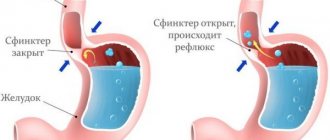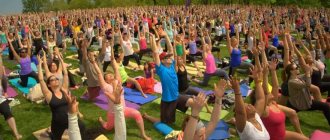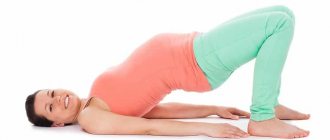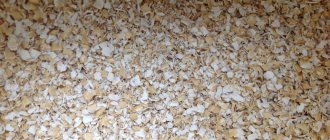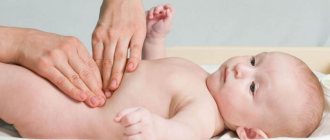What is constipation in an elderly person?
The fact that an elderly person has developed constipation can be judged by the following signs:
- no bowel movements for more than 2 days or bowel movements less than 3 times a week;
- an elderly person goes to the toilet more than three times a week, but bowel movements require physical effort or are painful;
- feces resembles “sheep’s”: it comes out in small and extremely hard pieces;
- after going to the toilet there is a feeling of incomplete bowel movement;
- To carry out defecation, auxiliary methods performed by hands are required: evacuation of contents from the rectum, pressing on the perineum.
Features of constipation in old age
Constipation is a disorder of bowel movement, characterized by the following symptoms:
- there is an increase in the intervals between bowel movements (less than once every 2–3 days);
- difficult bowel movements;
- feeling of incomplete bowel movement;
- the need for additional manipulations.
The development of constipation in old age is associated with many factors: slower peristalsis, physical inactivity, a decrease in solid foods in the diet, chronic diseases, and taking medications to treat underlying diseases.
The most common reasons are:
- Malnutrition: insufficient consumption of solid foods, fiber, water.
- Changing the usual conditions. Often, reflex retention of stool occurs when changing place of residence (including during hospitalization), climate, other conditions, or under the influence of stress.
- Physical inactivity, prolonged bed rest.
- Diseases of the gastrointestinal tract: hemorrhoids, proctitis, colitis, rectal prolapse, anal fissure.
- Diseases of other organs. Endocrine disorders (hypothyroidism, diabetes mellitus), heart failure, and liver disease contribute to the occurrence of constipation.
- Side effects of medications. Antispasmodics, muscle relaxants, bismuth preparations, antidepressants (Amitriptyline), and diuretics can slow down bowel emptying.
- Tumor formations. The tumor leads to a narrowing of the intestine, which is clinically manifested by stool retention.
This must be taken into account when determining treatment tactics. To combat constipation, it is not always enough to change your diet and take laxatives; you must identify the cause of bowel dysfunction.
Main causes of constipation and their symptoms
Stool retention can be of three types:
- Acute, which is also accompanied by gas retention, a feeling of bloating, and pain in the abdomen. This is how diseases manifest themselves that can be treated in an emergency only by surgery. This is mesenteric thrombosis (blockage of blood vessels supplying the intestines), as well as acute intestinal obstruction, which can be caused by adhesions, tumors, diverticula, and elongation of the sigmoid colon, which often occurs in old age.
- Episodic stool retention. It is usually associated with a violation of the diet, drinking small volumes of water for some time.
- Chronic constipation. They talk about it when the signs of constipation that we discussed in the previous section are observed for at least six months. Let's consider this pathology in more detail.
The main cause of chronic constipation in older people is a decrease in the tone of the muscles of the intestinal wall (intestinal atony). It develops as a result of physiological aging, when the motor activity of the muscles of the intestinal wall decreases. Simultaneously with atony, the sensitivity of the rectum worsens, and it stops sending signals to the brain that it is time to go to the toilet.
Intestinal atony develops earlier and is more severe in people who:
- suffer from atherosclerotic changes in the arteries feeding the intestines;
- did not receive adequate treatment for intestinal disease, for example, infectious inflammation or dysbiosis;
- suffer from diabetes;
- move little (especially when an elderly person is forced to lie down);
- follow a diet rich in simple carbohydrates but low in fiber;
- experience constant stress;
- take painkillers, iron-containing, diuretic, anticholinergic or gastric acid-reducing drugs, as well as sorbents, antidepressants, anti-epileptic drugs;
- infected with helminths;
- are obese;
- have reduced thyroid function;
- underwent surgery on the abdominal organs.
The fact that chronic constipation arose due to intestinal atony can be assumed on the basis of cramping pain in the abdomen, the urge to defecate, which does not end with it, belching and nausea.
The second reason why chronic constipation develops in older people is intestinal spasm. It develops as a result of frequent stress, poor diet (love of spicy foods, processed foods, alcohol), previous intestinal infections, helminth infections, and food allergies.
The following symptoms indicate that constipation is caused by colon spasms:
- painful urge to defecate, which does not always result in the release of feces;
- diarrhea that occurs after several days of constipation;
- feces - “sheep”, with mucus;
- frequent pain in the lower abdomen;
- insomnia;
- simultaneous release of both gases and mucus from the anus.
The third reason that causes chronic constipation is a tumor growing in the colon, but not completely blocking the intestinal lumen. Its symptoms are very similar to those that manifest spasm of the large intestine, since the part of the intestine above the tumor has to make an effort to push feces through it into the underlying sections.
Thus, you can see that the symptoms of atonic, spastic constipation or fecal retention due to a tumor appear very similar. They are treated completely differently. To get the right therapy, you need to contact a gastroenterologist who can accurately distinguish between these conditions.
Types of constipation
It is not difficult to “recognize” constipation: stool retention is always accompanied by additional unpleasant symptoms. Lack of timely assistance to the intestines leads to aggravation of the problem:
- The skin acquires a yellow tint and becomes flabby;
- Hair fall out;
- Nails peel and break quickly.
The transition of the disease to the chronic stage occurs due to the destruction of the anal mucosa. Feces become hard and cause pain during bowel movements.
The reasons why congestion occurs in the intestines are varied. Let's list the most common ones.
- Neurogenic constipation.
- People who find a change in environment uncomfortable often instinctively or consciously suppress the urge to defecate. They don’t want to go to the toilet in the forest, at a party, etc. Therefore, a one-time delay in bowel movements develops into chronic constipation.
- Also, the neurogenic nature of the pathology manifests itself due to the development of hemorrhoids. Cracks in the anus cause pain, which intensifies as stool passes. A person tries to subconsciously “put off” this moment, which causes even more problems with the intestines.
- Those who like to sleep for a long time also suffer from this type of constipation. They “miss” the urge to have a bowel movement. Therefore, the body stops sending signals about the need to go to the toilet.
- Alimentary constipation.
The disorders are caused by an unbalanced diet. It lies in the lack of the body’s daily needs for fluid, fiber and vitamins. Often the cause of its occurrence is the predominance of sweets and baked goods in the diet.
The pathology is caused by prolonged exposure to a static position and a sedentary lifestyle. Common among pregnant women and the elderly.
The disease occurs for physiological reasons:
- Pathologies in the colon;
- Intestinal compression of the rectum.
- Proctogenic constipation.
Appears under the influence of proctogenic causes:
- Reduced intestinal sensitivity;
- Hemorrhoids;
- Bleeding fissures in the anus.
- Acute constipation.
The development of the disease is provoked by inflammatory processes in the intestines or colon, colitis.
The disease is caused by a malfunction of the thyroid gland, as well as severe diabetes mellitus. Similar disorders appear in women during menopause against the background of a general hormonal imbalance.
Abnormalities of this type of stool are caused by long-term use of medications.
What are the dangers of constipation?
Chronic constipation must be treated, as it can lead to consequences of varying severity. The main complications of this condition are:
- Anal fissure. This is a condition when a rupture occurs in the mucous membrane lining the final section of the rectum due to injury from solid feces, which can have different shapes and different depths. If an acute fissure is not treated, it becomes chronic, which is accompanied by intense pain in the rectum, which becomes unbearable when visiting the toilet. Also, a rectal fissure can become infected (stool is nonsterile). In this case, an abscess may develop - paraproctitis; absorption of bacteria into the blood can lead to infection of the latter - sepsis.
- Haemorrhoids. This is an expansion of the vascular plexuses located in the rectum, which, when straining, bleed, sometimes quite heavily. In addition to bleeding, which, when repeated frequently, causes anemia, hemorrhoids cause severe pain in the rectum.
- Chronic intoxication. The main tasks of the large intestine are to absorb excess fluid from feces, and also to move them further into the ampulla of the rectum. When stool stops moving (as a result of constipation or intestinal spasm), the absorption of fluid from it does not stop, and toxic substances that should have been removed with the stool enter the bloodstream with this fluid. They poison the body.
- If constipation in older people is treated independently, only with the help of laxatives (any: both drops and suppositories), their intestines will become “lazy” and will not want to work independently, waiting for the next dose of the drug. It is very difficult to overcome this problem.
- Diverticulosis of the colon is the appearance of protrusions – “pockets” – in the intestine. Food often remains in them, which causes inflammation and intoxication. And if the inflammatory changes in the wall of the diverticulum do not regress, its cells gradually degenerate into cancer.
To prevent the development of such consequences, you need to take your elderly relative to a gastroenterologist and undergo the examinations prescribed by him (usually an abdominal x-ray with contrast, ultrasound and stool examination). And although such a diagnosis requires preparation in terms of following a 3-day diet and taking Activated Carbon or another sorbent, only based on its results will the correct treatment be prescribed. If the patient is bedridden, then the help of a local therapist is required.
Colon irrigation
This is the scientific name for an enema. It can be used as first aid for constipation, but only on the condition that you do everything strictly according to the instructions.
So, first you need to go to the pharmacy. There you need to purchase: 1) the rubber “hot water bottle” itself with a tube extending from it, several plastic tips and a plastic clip (this set is called an Esmarch mug), 2) medical Vaseline or glycerin, 3) moisture-absorbing diapers 90*60 cm. If a relative already at such an age that he cannot quickly get to the toilet, and a diaper (diaper) for adults is excluded, then you also need to buy a duck (they are sold in pharmacies and medical equipment).
The following is the algorithm:
- Reassure your relative, tell him that today you will start working with him on more effective measures, but for now you will have to endure an enema 1-2 times, which, moreover, is not painful.
- Wash all parts of Esmarch's mug under warm soapy water. The tip must be boiled for at least 3 minutes.
- Fill Esmarch's mug with cool or cold water (18-23°C) in a volume of 1-1.5 liters. Under no circumstances should the water be warm, as it will then be absorbed into the rectum and increase the volume of fluid in the vessels, which is life-threatening. Extremely cold water is also dangerous: by irritating the receptors of the rectum, it can disrupt the functioning of the heart through the vagus nerve.
- Clamp the tube coming from the heating pad with a clamp. To do this, you need to squeeze the tube and insert it into the narrow part of the round plastic device that comes with Esmarch's mug. You will understand that everything was done correctly by the fact that water does not flow out of the raised “heater” through the tip.
- Place a moisture-absorbing diaper on the bottom half of the bed, where the elderly person's buttocks lie. This will help prevent the bed from getting wet.
- You are putting your relative to bed. Optimally - on the left side. But if he is lying down, and there may be problems with fluid leakage, then he needs to lie on his back and put a bedpan under his buttocks.
- Using a clean gloved hand, lubricate the tip with petroleum jelly or glycerin.
- Ask your relative to relax and gently, without pressing, insert the tip 3-5 cm into the rectum.
- Fixing the tip with your left hand so that it does not fall out of the rectum, with your right hand lift the mug so that it is as high as possible, but not too tight.
- Slide the clamp on the tube so that the tube fits into the wide hole and water can flow out of it.
- Ask your relative if they feel their bowels filling with water. If not, close the tube with a clamp, carefully remove the tip and check that water is flowing over the toilet. If it does not leak, rinse the tip under running water until the tip channel is clear of feces and is passable.
- Repeat the manipulation.
- Pour in as much water as your elderly relative can hold. Ask him to say “No more” when he feels the urge to go to the toilet.
- Remove the tip from the anus with a gentle movement, cover the lower part of the body of the bedridden patient with a diaper or sheet and leave the room, warning him to call for help when finished. Place toilet paper or wet wipes next to it.
Reviews and expert opinion
People experiencing serious discomfort from delayed bowel movements claim that exercise combined with proper nutrition can eliminate even persistent constipation.
For constipation, I do yoga exercises: legs shoulder-width apart, knees slightly bent, palms on knees, body relaxed, inhale and exhale, then forcefully draw in and relax your stomach, 8 times in one exhale. This improves intestinal motility.
Million
https://www.u-mama.ru/forum/family/health/191926/index.html
A special set of exercises helps me well against slagging in the body and chronic constipation.
In the morning, while still lying in bed, easily massage your stomach in a circular motion with your fingertips, moving around your navel in a circle.
Lying on your back, knees bent, resting on your elbows and feet, slowly raise your pelvis and hold, count to 10 and lower your pelvis. Do the exercise in the morning and at night from 2 to 7 times.
Lying on your back, legs slightly bent at the knees, raise and lower your hips and pelvis (from 3 to 30 times). This very useful exercise moves a large muscle group.
Slonya
https://www.krasotulya.ru/telo/index.php?showtopic=620
I've tried everything and it doesn't help. I was wondering if I should try yoga? Where did everything go? Many Asanas (postures) produce a strong massage of internal organs that are impossible to reach. There is compression and subsequent relaxation of the organs, a sharp influx of new blood, and removal of toxins. Also Pranayama (Yogic breathing) with locks - (bandhas) - this is when the anus is compressed and massaged - and hemorrhoids and the prostate in men disappear. And of course - nutrition in accordance with your constitution.
Topor
https://forumjizni.ru/archive/index.php/t-9718.html
At one time I suffered from constipation, I also had a sedentary job, all medications and diets only help for as long as you take them. Salvation is movement and sufficient water. I’ve been going to yoga and belly dancing for half a year now, just one class a week of both – all the problems are gone as they never were. I really like it, it works the muscles that I need. Well, I try to drink more water.
Elerosh
https://forum.aromarti.ru/showthread.php?t=5474
Medical specialists also speak positively about exercise for the intestines. They advise performing simple exercises immediately after sleep, while in bed. This stimulates intestinal peristalsis. It is also necessary to maintain your physical fitness and sufficient physical activity throughout the day. Daily walking and gymnastics for 10–15 minutes 1–2 times a day will help with this.
Doctors recommend exercise for patients suffering from constipation.
Diet
The diet of an elderly person prone to constipation should contain a fairly large amount of fiber - dietary fiber, which causes the intestines to contract and push feces out. A large amount of fiber is contained:
- in vegetables: avocado, zucchini, beets, cabbage, carrots, pumpkin, spinach, tomatoes, celery, legumes;
- in fruits: apples, apricots, pears, plums;
- in berries: raspberries, strawberries;
- in dried fruits;
- in nuts and seeds;
- in second courses: durum pasta, oatmeal, boiled lentils, beans, chickpeas, black beans, boiled brown rice;
- in bran, which can be produced in the form of a dietary supplement, and is also found in bran bread;
- in the form of a dietary supplement called “Fiber”, which is produced by different companies.
From this list you need to limit foods such as celery, beans and pasta.
If an elderly person has almost no foods with a lot of fiber before, they should be introduced gradually, in small amounts first of one, then of another product. If you immediately feed a relative a large amount of a healthy vegetable or fruit, he may experience bloating and even, if peristalsis increases too much, intussusception.
The second rule of a diet to treat constipation is to drink enough fluids. Only in this case will the fiber be able to swell and, like a sponge, cleanse the intestines of contents. If an elderly person does not suffer from heart or kidney failure, then in cool seasons he should receive 30 ml for every kilogram of his weight per day. This includes not only water, but also teas, broths, and compotes.
Consumption of fermented milk products rather than milk is mandatory. They contain beneficial bacteria that aid digestion. In addition, they contain calcium, which is important for a person suffering from constipation: calcium is not only needed to prevent osteoporosis, but is also used by muscle fibers for their work. It is optimal if the fermented milk products that you will give to your elderly relative are prepared at home (for example, from starter cultures sold in stores).
See also:
- Hypertension in old age
- 13 Online Dementia Tests: Check Your Brain Health
- Senile asthenia: causes and treatment
The following should be excluded from the diet:
- any smoked meats;
- fatty varieties of poultry, fish and meat;
- a large number of cheeses;
- boiled potatoes;
- White rice;
- White bread;
- ice cream;
- milk chocolate;
- cow's milk;
- baked goods;
- products made from yeast dough;
- carbonated drinks;
- strong teas;
- kvass;
- fast food;
- cocoa-containing drinks;
- alcohol;
- bananas;
- blueberries;
- radishes and radishes;
- mushrooms;
- jelly.
Include some fats in your first meal, which will “wake up” the gallbladder, and its bile will stimulate the intestines. It is best if it is a “snack”, for example, bread with a small piece of butter. It is better to make it 2 hours (for example, at 7:00) before the main breakfast, where, for example, you include oatmeal or muesli. Such a choleretic breakfast is contraindicated in case of exacerbation of inflammation of the gallbladder and in the presence of stones in it.
Number of meals in older people with constipation: 5-6.
Physical activity
Movement of the trunk and limbs is important for intestinal motility. The dependence here is direct: the more an elderly person moves, the more regular and better his bowel movements are. Therefore, if your relative is not bedridden, motivate him to go for a walk more often, but not sit on a bench, but walk. For this you can buy a dog.
If he is still able to perform at least primitive gymnastics or go to the swimming pool, even better. But if the relatives of a bedridden patient are reading these lines, then they need to know: to treat constipation, they will have to become an “engine” in the literal sense. This means that you will need to turn the elderly person over, bend and unbend his arms and legs at the joints, bring his legs bent at the knees to his stomach, and if the relative is not paralyzed, force him to perform the available movements himself.
For older people who are still active, this set of exercises can be recommended. It is performed in the morning, before meals. All exercises are performed in a supine position:
- Pull one knee to your chest, fix it with your hands for 2-5 seconds, return to the starting position. Repeat 4-5 times.
- Spread your arms out to the sides. Inhale – bend over and retract the anus. Exhale - return to the starting position. Repeat – 2-3 times.
- Exercise "scissors". Raise your straight legs off the floor, cross them together, moving them first vertically, then horizontally. Repeat – 4-5 times.
- Exercise “bicycle”: with bent legs, perform movements as if you were pedaling. You need to make 10-20 revolutions.
After this, go to the knee-elbow position, stand like that for a while. Now lift your straight legs one at a time, 4-5 times each.
The following exercises are performed standing with legs crossed:
- Stretch 4 times, retracting the rectum. Relax.
- As you inhale, raise your arms through your sides 4 times, retracting your anus. As you exhale, relax.
- Walk around.
Preparing to charge
Exercises for constipation do not require special preparation. However, before you start training, you need to take into account the following recommendations from doctors:
- Classes must be held every day;
- After normalization of bowel movements, classes can be reduced to 3-4 times a week;
- It is better to exercise immediately after waking up (this will help the body recharge with the right amount of energy for the whole day);
- The duration of classes is 20-30 minutes;
- In adults, exercises for constipation at the initial stage use simple exercises, gradually complicating them;
- The complex includes exercises that “work” all muscle groups;
- 20-30 minutes before the start of training, drink a glass of warm water.
Proper, rational nutrition, which enhances intestinal motility, will add to the effectiveness of training.
Drug treatment
For occasional constipation, the following medications can be used:
- which will stimulate the intestinal receptors, causing it to move. These are preparations of senna (Senade), picosulfate (Picolax, Guttalax); Castor oil;
- which will interfere with the absorption of water from the colon into the blood. These are “Magnesium sulfate”, “Karlovy Vary salt” and others;
- making stool more oily and soft so that it does not injure the intestinal walls. This is petroleum jelly or almond oil, which are sold in bottles at the pharmacy;
- osmotic drugs - those that promote the absorption of water from the blood into the intestines, as a result of which the volume of stool increases. The increased volume of intestinal contents better stimulates the intestinal receptors, which causes bowel movements. These drugs include lactulose preparations: “Dufalak”, “Normaze”, “Prelaxan”, “Lactuvit”. They are also a good substrate for the growth of beneficial bacteria in the intestines, suppress the activity of harmful bacteria, and remove ammonia from feces, which has a toxic effect on the brain.
Such drugs that increase the contents of the intestine by retaining water in it (Fortrans, Forlax) can only be used once before an ultrasound or x-ray of the intestine. They are prescribed by a doctor who has previously ruled out heart failure, intestinal obstruction, Crohn's disease and ulcerative colitis.
Occasional constipation in older people can also be treated with suppositories. They also come in several types:
- Suppositories that inhibit the absorption of water and electrolytes in the intestine, and thus increase intestinal motility. These are “Bisacodyl”, “Dulcolax”, as well as microenemas “Microlax”. They cannot be used for acute hemorrhoids, spastic constipation, acute proctitis, intestinal obstruction, and bleeding from the intestines.
- Suppositories that promote the production of gases in the intestines, which should push the intestinal contents out. These are Evacue, Ferrolax and Calciolax. Approved for use for hemorrhoids and rectal fissures.
- Suppositories that irritate the walls of the rectum, causing it to contract. These are glycerin-based drugs that cannot be used for exacerbation of hemorrhoids. They are called “Suppositories with glycerin” or “Glycelax”.
- Suppositories with oils, for example, “Sea Buckthorn Candles”. They soften stool while stimulating healing in the rectum. They can be used for hemorrhoids and for cracks or ulcers of the rectum. The only contraindications are allergies to sea buckthorn.
The listed remedies can be used only in the absence of contraindications and for a short course. Only a doctor can prescribe them after examination, so as not to harm the intestines.
In addition to the usual laxatives, modern drugs are also used that enhance peristalsis more gently. This:
- "Lubiproston";
- "Plecanatide" (analogue of "Linaclotide");
- "Norcisapride" (analogues of "Prucaloprid" and "Velusetrag");
- "Elobixibat".
But to cure constipation in older people, it is not enough just to take laxatives, which, moreover, cause lazy bowel syndrome. It is also necessary to examine the body for diseases that may aggravate the condition of the intestines. We talked about them: atherosclerosis, diabetes mellitus, parkinsonism, neurological diseases, hypothyroidism, helminthiases. Without adequate treatment for these diseases, stimulation of intestinal motility alone will not cure chronic constipation.
Physiotherapy
For constipation in older people, the following procedures are used:
- electrophoresis or with antispasmodics (for intestinal spasms), or with agents that stimulate peristalsis and vitamin B6 (for atony). For tumors, electrophoresis is contraindicated;
- amplipulse (with atony);
- warm baths, for example, pine baths (for intestinal spasms);
- mud therapy (more indicated for intestinal spasms);
- electromud procedures (a combination of electrophoresis and mud therapy);
- diadynamic currents (for spasms and atony, different modes should be used);
- sinusoidal currents (with atony);
- electropuncture (for atony).
Folk recipes
For periodic use for chronic constipation, you can use the following folk recipes:
- Raisin decoction. Take 30 g of raisins, pour 300 ml of boiling water, leave for 2 hours. After this, give it to an elderly person 100 ml once a day.
- Lemon juice with honey. Take 200 ml of water, add 1 tbsp. squeezed lemon juice and honey, as well as salt on the tip of a knife. Take this mixture on an empty stomach, half an hour before breakfast. If you have high acidity, take this remedy in the evening.
- Kefir with sunflower oil. Take 250 ml of kefir, add 1 tbsp. refined sunflower oil, mix, drink before bed.
- Infusion of senna with prunes. Take 2 tsp. leaves of this plant, mix with 100 g of prunes, pour 500 ml of boiling water. You need to leave for 3 hours and then strain. Take 5 tbsp of this medicine. in a week.
- Rhubarb decoction. Pour 200 ml of boiling water into a saucepan, add 20 g of chopped rhubarb root, boil for 10 minutes, and then leave for 2 hours. This entire glass of decoction should be drunk before bed.
Operation
In case of severe chronic constipation and the lack of proper effect from complex therapeutic treatment (diet + physical activity + taking medications and folk remedies), an operation - colonectomy - may be performed. It can be complete when the large intestine is completely removed and the small intestine is directly connected to the rectum. A colonectomy can be a partial colonectomy, where only part of the colon is removed. The point of the operation is that the contents of the small intestine are liquid, so they will not linger in the intestines, and if there is no large intestine, they will immediately come out. A complete colonectomy leads to the development of diarrhea.
What is better to choose for hemorrhoids and constipation?
All physical exercises of varying degrees of stress have a beneficial effect on intestinal function and restoration. To forget about constipation forever, you need to exercise regularly. This can be done not only in the gym, but also at home.
In addition to physical exercise, you need to walk long distances more often, jump rope, and squat.
Gymnastics for constipation and hemorrhoids is an effective remedy. When performing strength exercises, you can stop taking laxatives and improve the functioning of your body on your own.


